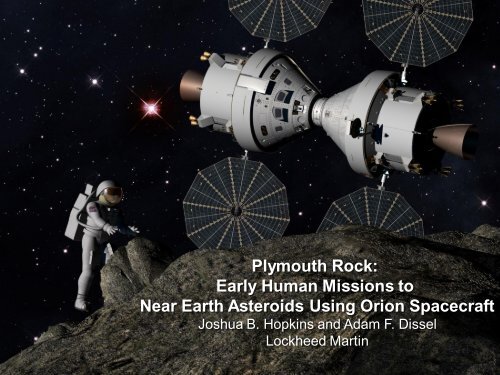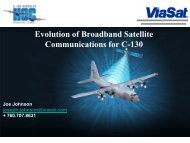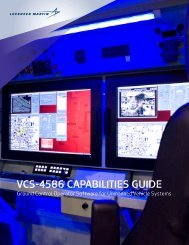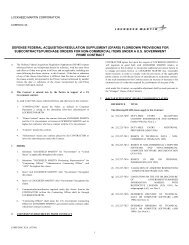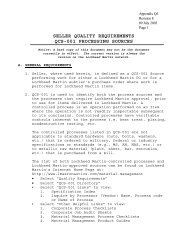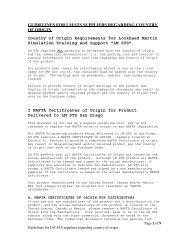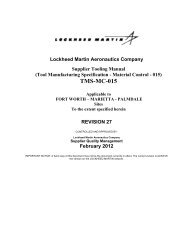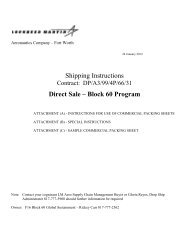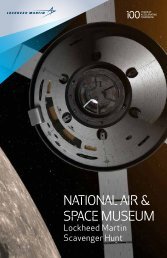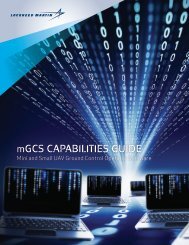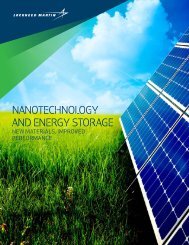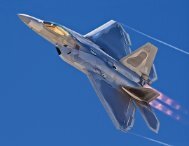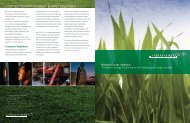Orion Asteroid Briefing Charts - Lockheed Martin
Orion Asteroid Briefing Charts - Lockheed Martin
Orion Asteroid Briefing Charts - Lockheed Martin
Create successful ePaper yourself
Turn your PDF publications into a flip-book with our unique Google optimized e-Paper software.
Plymouth Rock:Early Human Missions toNear Earth <strong>Asteroid</strong>s Using <strong>Orion</strong> SpacecraftJoshua B. Hopkins and Adam F. Dissel<strong>Lockheed</strong> <strong>Martin</strong>1
A New Destination for HumanSpaceflight• In the past ten years, astronomers havediscovered dozens of asteroids in Earth-like orbits– Discoveries are continuing• Some of these new asteroids are accessible withlunar-class exploration spacecraft and launchvehicles, rather than Mars-class systems• These recent discoveries are so new that theimplications for human spaceflight are still beingdetermined and are not incorporated in priorspaceflight planning– <strong>Asteroid</strong>s used to be the “beyond” in “Moon, Mars andBeyond,” but now they could be “Moon, Mars andBetween” or perhaps even “Before”3
<strong>Asteroid</strong> Orbits• Main Belt <strong>Asteroid</strong>s (~500,000 known)Most asteroids, like Ceres, orbit farbeyond Mars and are not yetaccessible for human missions• Near Earth <strong>Asteroid</strong>s(~7000 known) Someasteroids, like Eros, arenudged into elliptical orbitsin the inner solar system.They approach Earth, but athigh speed, so they are stilldifficult to visit• Accessible <strong>Asteroid</strong>s (dozens)A small fraction of the Near Earth<strong>Asteroid</strong>s, like 2008 EA9, are in Earthlikeorbits. They are close and theirvelocity relative to Earth is small,making easy round trips possible1 A.U.2 A.U.3 A.U.2008 EA9ErosCeres4
EccentricityEarth‟s Known Neighbors, circa 1990Era of Space Exploration Initiative, Stafford & Augustine Reports0.125(No Known Orbital Neighbors)0.10.0750.050.025<strong>Asteroid</strong> Inclinationsi < 11< i < 22< i < 33 < i < 5EARTH & MOONRegion ofAccessible Orbits00.9 0.95 1 1.05 1.1<strong>Asteroid</strong>s known as of year-end 1990Glyph size proportional to asteroid size (5-75 m)(Earth not to scale)Semi-Major Axis (A.U.)Image of Earth and Moon from Deep Impact, courtesy NASAMars at1.5 A.U.5
EccentricityEarth‟s Known Neighbors, Mid 2003Columbia Accident, Vision for Space Exploration Formulated0.1252000 LG60.11999 AO102001 QJ1420.0752001 GP22000 SG3440.050.025<strong>Asteroid</strong> Inclinationsi < 11< i < 22< i < 33 < i < 51991 VGEARTH & MOONRegion ofAccessible Orbits00.9 0.95 1 1.05 1.1<strong>Asteroid</strong>s known as of autumn 2003Glyph size proportional to asteroid size (5-75 m)(Earth not to scale)Semi-Major Axis (A.U.)Image of Earth and Moon from Deep Impact, courtesy NASAMars at1.5 A.U.6
EccentricityEarth‟s Known Neighbors, July 2009Era of Second Augustine Committee0.1250.12008 DL42004 QA222000 LG61999 AO102007 YF2007 DD2003 WP252006 BZ1472008 JL240.0752007 VU62000 SG3442008 KT2001 QJ1422006 JY262001 GP2 2008 EA92008 HU42008 UA2022007 UN120.050.025<strong>Asteroid</strong> Inclinationsi < 11< i < 22< i < 33 < i < 52003 YN1072006 QQ56 1991 VG2009 BD2006 RH120EARTH & MOONRegion ofAccessible Orbits00.9 0.95 1 1.05 1.1<strong>Asteroid</strong>s known as of summer 2009Glyph size proportional to asteroid size (5-75 m)(Earth not to scale)Semi-Major Axis (A.U.)Image of Earth and Moon from Deep Impact, courtesy NASAMars at1.5 A.U.7
Why Explore <strong>Asteroid</strong>s?• Knowledge– Study formation and history of our solar system– Correlate asteroid families to meteorite samples• Security– Enable deflection of future hazardous impactors by understandingstructure, composition, and how to operate around small asteroids• Wealth– Evaluate viability of asteroid resources for human expansion inspace• National Pride– Decisively re-establish American preeminence in space– Reduce the „exploration gap‟ before the next human lunar landing• Training– If a lunar mission precursor: Demonstrate lunar launch profile,LEO rendezvous, and <strong>Orion</strong> reentry at lunar-like entry speeds– As a Mars mission precursor: Learn to fly human missions in deepspace, with speed of light lag, radiation risk, and no resupply orrescue. <strong>Asteroid</strong>s are shorter, simpler practice for Mars missions.9
How Can We Explore the <strong>Asteroid</strong>s?• Favorable orbital alignments occur only a few timesper decade, so it may not make sense to design anew human spacecraft just for asteroid missions• <strong>Orion</strong> can be used to launch and return astronauts,but these missions need an additional spacecraftelement to provide more deep-space propulsion,living space, food, water, and oxygen• A second, modified <strong>Orion</strong> can be the additionalelement, rather than investing in new spacecraft– Provides capability and substantial redundancy at low costand within schedule timeframe without a new program start10
Mission Concept Utilizing Dual <strong>Orion</strong>s<strong>Asteroid</strong> Exploration(~5 days)<strong>Asteroid</strong> ArrivalManeuverTrans EarthInjectionLEOLEORendezvousEarthDepartureOutboundTransfer(~ 3 months)Return(~ 3 months)Re-entryHeavy Lift LaunchSupplemental<strong>Orion</strong> + EDS(Unmanned)Primary <strong>Orion</strong>Launch(Manned)Recovery• Plymouth Rock asteroid mission architecture mimics baselineConstellation lunar mission profile except:– A Supplemental <strong>Orion</strong> replaces the Altair lunar lander– <strong>Asteroid</strong> target replaces Moon– Crew of two rather than four due to limited volume and supplies11
<strong>Asteroid</strong> Exploration Operations• We can‟t „land‟ or „moonwalk‟ on an asteroid this small.Instead, spacewalk next to it, somewhat analogous tosatellite servicing missions of the 1980s.• First, rendezvous with the asteroid and observe from severalkm away for basic mapping and to look for co-orbitingdebris• Then, approach closer and station keep ~100 meters away– Keeping the spacecraft some distance from the asteroid ratherthan landing simplifies power, communications, thermal, GNC,etc.• Depressurize one <strong>Orion</strong> crew module to perform spacewalks• Use an MMU-like spacesuit propulsion system to approachan asteroid and collect samples• Small asteroids likely have negative surface gravity due torapid rotation periods– Makes EVA operations challenging– Probably means these asteroids don‟t have loose gravel orregolith that would be easy to sample• Many open questions are still to be resolved regarding howto perform EVAs near asteroids12
Launch Vehicle Needs• A variety of launch architectures are viable for theeasiest human asteroid missions• Dual-<strong>Orion</strong> asteroid missions require launch ofabout 43-47 tons to C3 = +1 to +4 km 2 /s 2 (slightlyfaster than escape velocity)– This is roughly comparable to launching 45-60 mt to translunarinjection (C3 = -1.8 km 2 /s 2 ) depending on the launchapproach– This is somewhat smaller than the planned performance ofAres V13
Trajectory Design Considerations• Two <strong>Orion</strong>s have just enough propellant to reach the easiestasteroids– Currently estimating 0.6-0.7 km/s ∆V available fromsupplemental <strong>Orion</strong> for asteroid arrival maneuver when both<strong>Orion</strong>s are mated, and 1.0-1.1 km/s ∆V from primary <strong>Orion</strong> alonefor Trans-Earth Injection– Budget for LEO insertion, flight performance reserve, trajectorycorrection maneuvers, and launch windows accounted forseparately• Reentry velocity is similar to lunar return– Reentry velocities are 11.05 to 11.25 km/s for the easiestasteroid missions, vs 11.0 km/s for lunar return– Using trajectory shaping it should be possible to performasteroid mission reentry at these velocities within existing<strong>Orion</strong> TPS capabilities– More difficult asteroids or faster missions would have higherentry velocities and may require design modifications14
<strong>Asteroid</strong> Mission Opportunities 2015-2030Using Dual <strong>Orion</strong> or <strong>Orion</strong> + Altair<strong>Asteroid</strong>LaunchDateDiameterMission Duration for Various PropulsionCapabilitiesPrime<strong>Orion</strong>Offloadedfor Ares 1Prime<strong>Orion</strong> FullProp Load50% MoreProp in Each<strong>Orion</strong>• Repeat opportunities with a specific asteroid are usually decadesapart• At the current asteroid discovery rate, the number of knownmission opportunities in this time frame may double by 2015<strong>Orion</strong> +Altair(low boiloff)2008 HU4 Apr 2016 7-10 m Not feasible 195 days 90 days 70 days1991 VG Jul 2017 6-9 m 230 days 215 days 175 days 150 days2008 EA9 Nov 2019 8-12 m 200 days 195 days 160 days 145 days2007 UN12 Jul 2020 5-8 m 235 days 230 days 210 days 195 days1999 AO10 Aug 2025 50-70 m Not feasible Not feasible Not feasible 165 days2008 JL24 Feb 2026 4-5 m Not feasible Not feasible Not feasible 205 days2006 RH120 Jun 2028 4-5 m 145 days 135 days 100 days 80 days2000 SG344 Jul 2029 30-45 m 150 days 145 days 120 days 105 days15
2019 Opportunity: 2008 EA916
2019 Opportunity: 2008 EA9• Spacecraft ΔV (asteroid arrival ΔV + asteroid departure ΔV )vs launch date17
Habitability and Life Support• Two <strong>Orion</strong>s together provide just enoughhabitable volume for two astronauts (~9 m 3 each)• Dual <strong>Orion</strong>s can accommodate additional food,water, and oxygen needed for two people on 180day missions within volume and mass limits– The crewed <strong>Orion</strong> launch is mass constrained by launchperformance and the capability of the launch abortsystem and recovery system. Therefore, most of theadditional consumables are launched in thesupplemental <strong>Orion</strong>– Consumables are budgeted and allocated to support anemergency return using either <strong>Orion</strong> alone– Waste and trash management are a challenge18
Life Support Consumables• Use existing <strong>Orion</strong> open loop life support system for reliability• Sized for fault tolerance, plus vehicle-level redundancy duringoutbound trip• There is room to package ECLSS consumables in the ServiceModule and Crew Module for up to ~6 month missionsLife Support Consumables Required for Two-PersonMissions of Various Durations120 Day 150 Day 180 Day 210 DayWater 698 kg 868 kg 1037 kg 1207 kgNitrogen 79 kg 86 kg 86 kg 86 kgOxygen 391 kg 454 kg 489 kg 542 kgFood 450 kg 560 kg 670 kg 779 kgTOTAL 1618 kg 1967 kg 2282 kg 2615 kg19
Radiation• Radiation analysis and design effort for <strong>Orion</strong> lunarmissions is largely applicable to asteroid missions due tosimilar design environments• <strong>Orion</strong> is required to shield crewmembers so that the effectivedose from a solar flare is E ≤150 mSv using August 1972King SPE referenceenvironment• Cosmic ray equivalent dose isE ~ 1.4 mSv/day• Mission durations of up to 6-7months have reasonableradiation doses. Longermissions are questionable.20
Enhanced <strong>Orion</strong> Deep Space Vehicle2 AdvancedMMUs WithDockingStationsDockingSystemAl AlloyOrthogridWeldedStructureEVAHatchMMODCoversHab/SMUmbilicalPanelService ModuleAttach PointsEVAEquipmentOxygenTanksNitrogen Tanks• An option for larger living space, more life support supplies,and better EVA support, using standard <strong>Orion</strong> components21
Conclusions• <strong>Asteroid</strong>s in Earth-like orbits represent a newly discoveredclass of accessible human exploration destinations• Favorable orbital alignments occur a few times per decade– Only about 0.1% of near Earth asteroids are accessible for humans,limiting our ability to pick the most interesting destinations• Round trip visits to these asteroids are comparable in difficultyto visiting the Moon– Lower ΔV but longer duration• A dual <strong>Orion</strong> approach, dubbed Plymouth Rock, is capable of aminimalist mission to a few of the easiest asteroids• More frequent or more capable missions would require a moreadvanced <strong>Orion</strong> derivative or a dedicated mission module tocomplement the existing <strong>Orion</strong>• Future missions would benefit from increased investment nowfor detecting and characterizing small asteroids22
© 2010 <strong>Lockheed</strong> <strong>Martin</strong> Corporation.All Rights Reserved23


